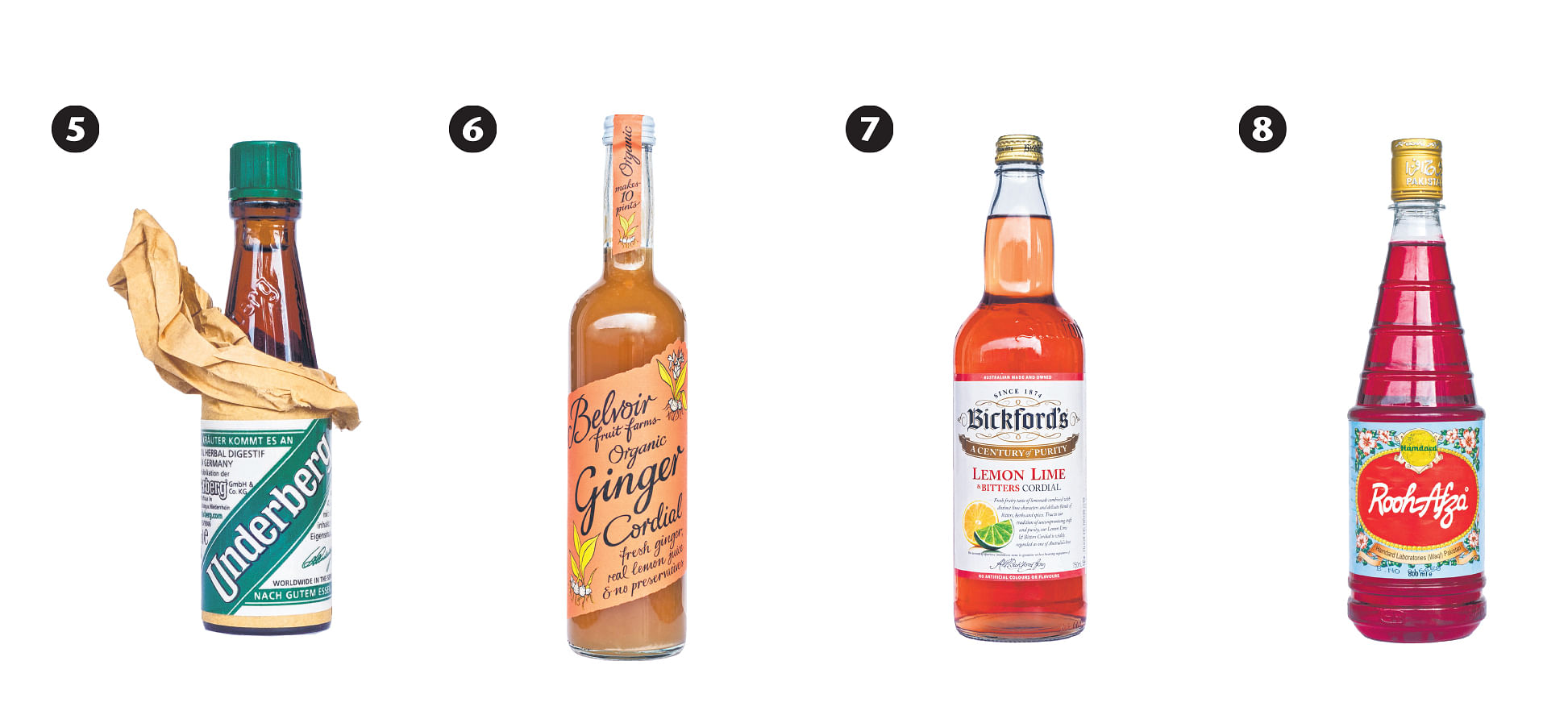Here are bar mainstays which add zesty, spicy and bitter notes to drinks. Look for them at supermarkets and wine stores.
• Medicinal cordials: Dating back at least to the early 15th century, these European preparations were made by steeping plant materials and other ingredients in alcohol and were consumed in small amounts as folk medicine. Many of the modern drinks listed below, which are nowadays more recreational than medicinal, descended from them.
• Aromatic bitters: A concentrated herb-and-spice infusion usually based on alcohol and water and named for its bitter taste. It was developed in the 18th century for its medicinal properties and is nowadays used more as a beverage flavour accent. Shown here is Angostura bitters from Venezuela (photo 1). Its lightly spiced notes grace many cocktails, including the Singapore Sling. Unusual commercial and house-made bitters with ingredients such as chocolate, celery and lavender, as well as bitters-centric cocktails, have been significant mixology trends in recent years.
• Aperitif: A European pre-meal drink meant to stimulate the appetite for the subsequent repast. It is often infused with botanicals and is more often dry than sweet. Shown here is Lillet Rouge (photo 2), based on merlot wine. It is also a quinquina, a class of aperitifs which contains quinine and was originally created for its anti-malarial properties. Other famous aperitifs include Aperol, Pastis and Dubonnet.

• Digestif: A post-meal drink taken to aid digestion, usually containing extracts of plants traditionally thought to improve intestinal health. Most digestifs are alcoholic and often comparatively higher in alcohol and/or sweeter than aperitifs. Shown here is traditional German digestif kirschwasser (photo 3), a double-distilled cherry brandy, perhaps most familiar as an ingredient in Black Forest Cake.
• Amaro: An Italian liqueur digestif whose name literally and aptly translates as "bitter". It derives its nuances from a wide spectrum of bitter herbs such as cinchona bark, wormwood, gentian and liquorice. Shown here is Fernet Branca (photo 4), a Milanese amaro whose complex blend of botanicals includes myrrh, chamomile, galangal, linden, cinnamon and saffron.
• Krauterlikor: A German style of herb liqueur digestif, usually very potent and sweeter than other bitters. Shown here is Underberg (photo 5), an oak-aged krauterlikor characteristically sold in small, paper-wrapped, single-dose bottles. Another common krauterlikor is Jagermeister.

• English cordials: Non-alcoholic concentrates made from fruit, flowers or herbs, plus sugar or other sweeteners, typically diluted with still or sparkling water to make beverages. Popular flavours include citrus fruit; ginger (photo 6); berries and small soft fruit, such as raspberries and blackcurrants; flowers, such as roses and elderflowers, both very traditional in cordials; and, in more modern recipes, tropical fruit such as mango. Also shown here is a lemon lime bitters cordial (photo 7), a bitters-flavoured but non-alcoholic cordial based on a drink popular in Australia and New Zealand.
• American cordials: In the United States, cordials usually refer to alcoholic drinks, such as sweetened liqueur, consumed undiluted or in cocktails. Liquor-filled chocolates are also called cordials.
• Other cordials: In the Middle East, West Asia and South Asia, fruit, flowers, herbs, spices and sometimes nuts are made into non-alcoholic cordials, often used in iced drinks served during the hot months. Look for them here at Indian grocery stores. Shown here is Rooh Afza (photo 8), a traditional syrup made from roses and other flowers, herbs, fruits and vegetables, enjoyed in both India and Pakistan over ice or mixed with milk.
Text and photos: Chris Tan
